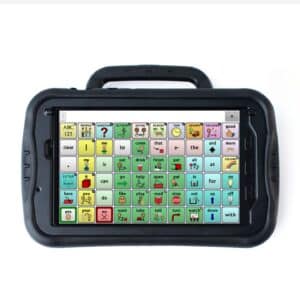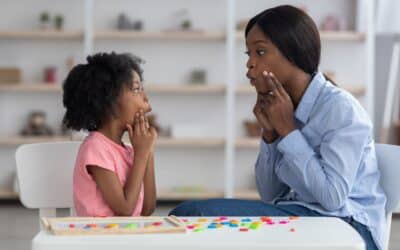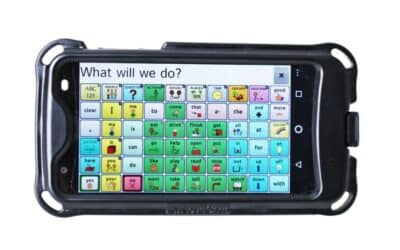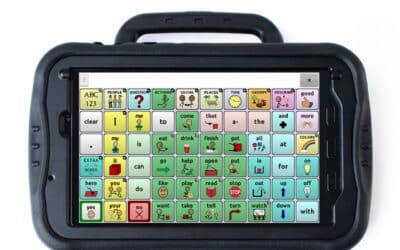For parents navigating the complexities of communication delays in their hearing children, both sign language and picture communication (paired with spoken language models) offer valuable tools for expression. But which of these Augmentative and Alternative Communication (AAC) methods, or combination of methods, is right for your child? Let’s explore both strategies, highlighting their benefits, and comparing them to ensure you make an informed choice. In this article, we will answer the question, “How do sign language and pictures help hearing children communicate?”
Definition of Sign Language
- Visual and Movement Based Communication Tool: Sign language is a visual and movement-based communication system of hand and arm positions and movement and facial expressions originally used in the hearing impaired and deaf communities. It enables hearing children to communicate needs, feelings, and thoughts, reducing frustration and improving understanding between the child and caregiver.
- Enhances Language Understanding and Use: It aids in language development by introducing children to a visual and kinesthetic form of communication, helping them connect signs with their meanings and promoting earlier and richer verbal skills.
- Development and Adaptability: Using sign language can improve memory, attention, vocabulary, and grammar in children, and encourage social language interaction and emotional expression, leading to better social relationships and emotional understanding. Just like the understanding and use of spoken language is a process, so is the understanding and use of sign language.

How Does the Use of Sign Language Help Hearing Children Communicate?
- Valuable Communication Tool: Sign language is a significant communication aid for hearing children with speech-language delays, using hand shapes and movements to represent words and concepts.
- Expressive and Reduces Frustration: It allows children to express their needs, feelings, and thoughts, significantly reducing frustration and behavioral issues due to communication challenges.
- Stimulates Language Development: Sign language aids language development by providing a visual and kinesthetic connection to language.
- Enhances Social Interaction: Incorporating sign language into daily routines improves children’s engagement and participation in social interactions.
- Transitional and Complementary: It can act as a transitional tool that bridges the gap while spoken language develops and can complement and enhance verbal language skills as they develop.
- Improves Understanding and Use of Language: Parents and caregivers using sign language often observe improvements in their child’s ability to understand and use language.
- Fosters Closer Bonds: Sign language creates a shared mode of communication, fostering closer emotional and social bonds between the child and those around them.

Definition of Picture Communication
- Visual-Based Communication Tool: A Picture Communication System (PCS) is a visual tool that uses images, symbols, or photographs to represent concepts, objects, and actions. This system is designed to aid communication for individuals who have speech-language delay and speech-language disorder.
- Enhances Expression and Understanding: By pointing to or selecting these pictures, users can effectively convey their needs, feelings, and thoughts. This method facilitates communication, particularly for those who find verbal communication challenging. It helps in reducing frustrations associated with the inability to express oneself and improves overall understanding between the user and others.
- Development and Adaptability: PCS is not only a communication aid but also a developmental tool. It supports language development by linking visual symbols with their corresponding words and concepts. As a user’s communication skills evolve, the complexity and variety of the pictures can be adjusted to match their growing abilities, making it a flexible and adaptable system.

How Do Pictures Help Hearing Children Communicate?
- Bridge for Expression: Picture communication systems act as a bridge between thoughts and spoken words, helping hearing children with speech-language challenges express themselves when verbal communication is difficult.
- Effective Communication and Reduced Frustration: Children can use these systems to point or show pictures, effectively conveying their needs, feelings, and thoughts. This reduces frustration and improves their ability to interact with others.
- Supports Language Development: These systems aid in daily communication and encourage children to make connections between objects, actions, and their corresponding words, supporting language development.
- Adaptable with Skill Improvement: As a child’s verbal skills improve, picture systems can be adapted to become more complex, aiding in the ongoing growth of speech and language abilities.
- Boosts Confidence: Engaging with picture communication systems often increases a child’s confidence, as they feel empowered by being understood and having their needs met.
- Leverages Visual Learning Strengths: This approach is effective as it utilizes the visual learning strengths many children have, offering an accessible and enjoyable way for them to learn and communicate.
Comparing Sign Language and Picture Communication
When comparing sign language and picture communication for children with speech, language, and communication difficulties, it’s important to consider their distinct advantages and suitability for different needs. Sign language offers a dynamic, interactive form of communication, involving gestures, which can be particularly engaging for children. It’s beneficial for fostering the understanding and use of language and does not require any outside tool so it is always available to the child. For expression, a child does need sufficient motor skills to make or approximate the movements to produce the sign.
Picture communication, on the other hand, uses visual symbols or images to convey messages. This method can be more straightforward for children who have difficulty with the fine motor skills required for signing. It also allows for a clear and concrete way of communicating needs and thoughts and can be especially helpful for children who respond well to visual aids.
Both methods aim to provide an augmentative or alternative means of communication for children who face challenges with speech and language. When making a choice, consider the individual child’s development, learning style, and specific communication needs. While sign language can foster a more direct form of interactive communication, picture communication can offer a simpler, more immediate way of expressing basic needs and ideas. Sign language and pictures can both help hearing children communicate and many use both methods.
Teaching Your Child to Use Pictures and Sign Language
For both methods, consistency is key. Pair the sign or picture with the spoken word every time (or as often as possible). Naturally integrate signs and/or pictures during play and daily routines.
Helping Your Child’s Use Sign Language and Pictures
- Model, Model, Model: Regularly use the chosen method alongside spoken words.
- Encourage Imitation: Celebrate when your child tries to or uses a sign or picture to communicate.
- Expand Vocabulary: Introduced more complex vocabulary after functional vocabulary (relevant for daily routines) is mastered.
- Engage in Conversation: Use a signs and pictures paired with spoken words during communication exchanges.
FAQs
- Can we use both spoken words, sign language and pictures together to help our child communicate?
- Absolutely. Many families find value in blending methods for comprehensive support for a total communication approach.
- Are there any drawbacks to these methods?
- Using sign language and pictures requires patience, consistency, and conversation partner understanding of these methods. In terms of their ability to support a child’s improved language, speech, and communication and reduced frustration, they are golden.
- Should we use the spoken words when we sign and use pictures?
- Yes, always pair the use of sign language and pictures with spoken words.
Additional Resources
- American Sign Language Browser
- Signing Time: Resources for Parents
- What is Makaton? – About Makaton
- 11 Tips to Improve a Child’s Communication Using Signs (asha.org)
- Using-Visuals-to-Support-Communication.pdf (ncse.ie)
- Augmentative & Alternative Communication | Parent Resources (pathways.org)
Summary/Conclusion
In this article we discussed how sign language and pictures can help hearing children communicate. Whether you opt for sign language, picture communication, or a combination of both, the key is modeling, practice, consistency and patience. Both tools have the potential to significantly enhance your child’s ability to understand language, express themselves, and interact with the world around them. Sign language and pictures paired with spoken language can have a powerful impact on a child’s speech, language, communication, and overall development.




0 Comments